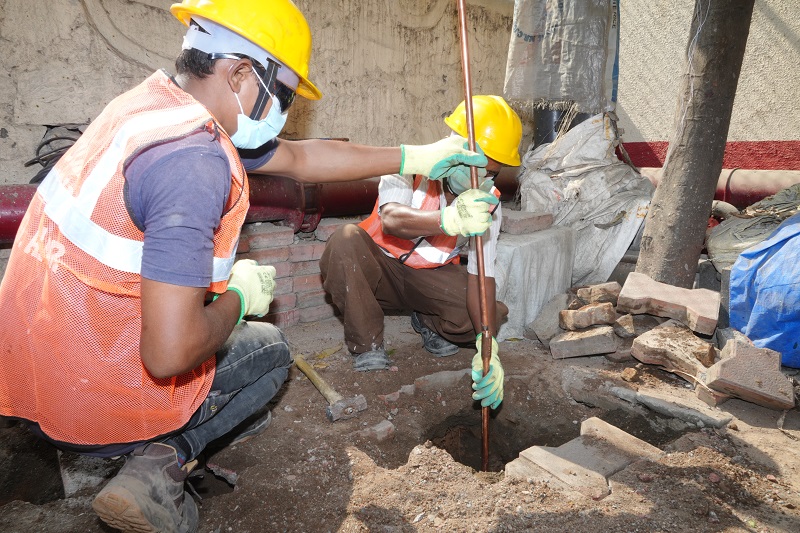In the realm of electrical grounding, one method stands out due to its unique approach and historical significance: Ufer Grounding. Officially recognized as a concrete-encased grounding electrode in the National Electrical Code (NEC), this grounding technique has proven to be a reliable solution, particularly in arid regions where conventional grounding systems may falter.
The inception of the Ufer Grounding system was driven by the exigencies of World War II. The U.S. Army required an efficient grounding system for their bomb storage vaults located in the arid terrains of Arizona. Traditional grounding systems, which necessitated driving rods into the earth, were not feasible due to the absence of a water table and minimal rainfall.
Herbert G. Ufer, a consultant for the U.S. Army, was tasked with devising a more practical and cost-effective solution. Ufer discovered that concrete, due to its inherent properties, exhibited better conductivity than most types of soil. This led to the development of a grounding scheme that involved encasing the grounding conductors in concrete. This innovative method proved to be highly effective and was subsequently implemented throughout the Arizona test site.
The Ufer Grounding system is predicated on the principle of embedding a metal rod into a concrete foundation. Concrete, being naturally basic with a high pH, provides an abundant supply of ions, thereby offering a better electrical ground than almost any type of soil.
The concrete enclosure increases the surface area of the connection between the grounding conductor and the surrounding soil. This augmentation in surface area helps to reduce the overall impedance of the connection, thereby enhancing the grounding system’s effectiveness.
Ufer’s original grounding scheme utilized copper encased in concrete. However, the high pH of concrete often causes the copper to chip and flake. To circumvent this issue, steel is often used instead of copper. In regions where homes are built on concrete slabs, it is common practice to extend one end of the rebar out of the concrete, providing an accessible connection point for the grounding electrode.


The Efficacy of Ufer Grounding
Ufer Grounding offers several advantages. It is cost-effective, requires less physical space, and provides a low-resistance path to ground, making it an excellent choice for lightning protection. In some jurisdictions, such as Des Moines, Iowa, Ufer Grounds are mandated for all residential and commercial buildings.
However, Ufer Grounding also has its drawbacks. The moisture in the concrete can flash into steam during a lightning strike or similar high energy fault condition. This can lead to cracking of the surrounding concrete and potential damage to the building foundation.
To fully appreciate the technical nuances of Ufer Grounding, it’s essential to delve into the specifics of its construction and application. The concrete-encased electrode can be bare, zinc-galvanized, or other steel reinforcing bars or rods of not less than ½ inch in diameter coated in electrically conductive material. It can be installed in one continuous 20-foot length, or, if in multiple pieces, it can be connected by the usual steel tie wires, exothermic welding, welding, or other effective means to create a 20-foot or greater length.
The 20 feet of conductive rods or bare wire used in creating a concrete-encased electrode only establishes the connection to the concrete. The combination of the concrete and the conductive component serve as the grounding electrode as clarified in the definition of the term.
The Future of Ufer Grounding
Despite its proven effectiveness, the use of Ufer Grounding is not universally accepted, particularly in large process and power plants. This reluctance can be attributed to a lack of understanding of the use of concrete encased electrodes, fear of failure during final inspection, and a lack of motivation to adopt a “new” method. However, with the potential cost savings and the ability to mitigate underground corrosion due to the presence of differing metals, Ufer Grounding is a method that warrants further exploration and consideration.


Ufer Grounding is a unique and effective method of electrical grounding that has stood the test of time. While it may not be the most commonly used method today, its benefits make it a viable option for many applications. As we continue to develop and refine our grounding techniques, the Ufer Grounding system serves as a reminder of the innovative solutions that can arise from challenging circumstances.
Thank you for reading the blog, Axis is a leading manufacturer and supplier of AB Cable Accessories and other Electrical Components to over 80+ Countries. To get a quote or to talk to our industry expert visit our contact us section. You can also watch our videos by our experts – click here.
